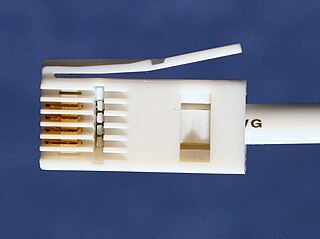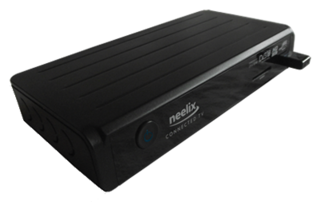In telecommunications, a customer-premises equipment or customer-provided equipment (CPE) is any terminal and associated equipment located at a subscriber's premises and connected with a carrier's telecommunication circuit at the demarcation point ("demarc"). The demarc is a point established in a building or complex to separate customer equipment from the equipment located in either the distribution infrastructure or central office of the communications service provider.

In telecommunications, a network interface device is a device that serves as the demarcation point between the carrier's local loop and the customer's premises wiring. Outdoor telephone NIDs also provide the subscriber with access to the station wiring and serve as a convenient test point for verification of loop integrity and of the subscriber’s inside wiring.
Telephony is the field of technology involving the development, application, and deployment of telecommunication services for the purpose of electronic transmission of voice, fax, or data, between distant parties. The history of telephony is intimately linked to the invention and development of the telephone.
Voice over Internet Protocol (VoIP), also called IP telephony, is a methodology and group of technologies for the delivery of voice communications and multimedia sessions over Internet Protocol (IP) networks, such as the Internet. The terms Internet telephony, broadband telephony, and broadband phone service specifically refer to the provisioning of communications services over the public Internet, rather than via the public switched telephone network (PSTN).
Plain old telephone service (POTS), or plain ordinary telephone service, is a retronym for voice-grade telephone service employing analog signal transmission over copper loops. POTS was the standard service offering from telephone companies from 1876 until 1988 in the United States when the Integrated Services Digital Network (ISDN) Basic Rate Interface (BRI) was introduced, followed by cellular telephone systems, and voice over IP (VoIP). POTS remains the basic form of residential and small business service connection to the telephone network in many parts of the world. The term reflects the technology that has been available since the introduction of the public telephone system in the late 19th century, in a form mostly unchanged despite the introduction of Touch-Tone dialing, electronic telephone exchanges and fiber-optic communication into the public switched telephone network (PSTN).

A digital subscriber line access multiplexer is a network device, often located in telephone exchanges, that connects multiple customer digital subscriber line (DSL) interfaces to a high-speed digital communications channel using multiplexing techniques.

In telephony, the demarcation point is the point at which the public switched telephone network ends and connects with the customer's on-premises wiring. It is the dividing line which determines who is responsible for installation and maintenance of wiring and equipment—customer/subscriber, or telephone company/provider. The demarcation point varies between countries and has changed over time.
A softswitch is a central device in a telecommunications network which connects telephone calls from one phone line to another, across a telecommunication network or the public Internet, entirely by means of software running on a general-purpose computer system. Most landline calls are routed by purpose-built electronic hardware; however, soft switches using general purpose servers and VoIP technology are becoming more popular.

A business telephone system is a multiline telephone system typically used in business environments, encompassing systems ranging from the small key telephone system (KTS) to the large private branch exchange (PBX).
The IP Multimedia Subsystem or IP Multimedia Core Network Subsystem (IMS) is an architectural framework for delivering IP multimedia services. Historically, mobile phones have provided voice call services over a circuit-switched-style network, rather than strictly over an IP packet-switched network. Alternative methods of delivering voice (VoIP) or other multimedia services have become available on smartphones, but they have not become standardized across the industry. IMS is an architectural framework to provide such standardization.
Cable telephony is a form of digital telephony over cable TV networks. A telephone interface installed at the customer's premises converts analog signals from the customer's in-home wiring to a digital signal, which is then sent over the cable connection to the company's switching center. The signal is then sent on to the public switched telephone network (PSTN). Cable telephone provides another revenue stream for cable television system operators and gives the consumer the convenience of a single bill for combined television, internet and telephone services.
Direct inward dialing (DID), also called direct dial-in (DDI) in Europe and Oceania, is a telecommunication service offered by telephone companies to subscribers who operate a private branch exchange (PBX) system. The feature provides service for multiple telephone numbers over one or more analog or digital physical circuits to the PBX, and transmits the dialed telephone number to the PBX so that a PBX extension is directly accessible for an outside caller, possibly by-passing an auto-attendant.

A VoIP phone or IP phone uses voice over IP technologies for placing and transmitting telephone calls over an IP network, such as the Internet, instead of the traditional public switched telephone network (PSTN).

AT&T U-verse, commonly called U-verse, is an AT&T brand of triple-play telecommunications services, although the brand is now only used in reference to the IPTV service. Launched on June 26, 2006, U-verse included broadband Internet, IP telephone, and IPTV services in 21 states.

Generic Access Network (GAN) extends mobile voice, data and multimedia applications over IP networks. Unlicensed Mobile Access (UMA) is the commercial name used by mobile carriers for external IP access into their core networks. The latest generation system is named Wi-Fi Calling or VoWiFi by a number of handset manufacturers, including Apple and Samsung, a move that is being mirrored by carriers like T-Mobile US and Vodafone.

In telecommunications, a femtocell is a small, low-power cellular base station, typically designed for use in a home or small business. A broader term which is more widespread in the industry is small cell, with femtocell as a subset. It is also called femto AccessPoint (AP). It connects to the service provider’s network via broadband ; current designs typically support four to eight simultaneously active mobile phones in a residential setting depending on version number and femtocell hardware, and eight to sixteen mobile phones in enterprise settings. A femtocell allows service providers to extend service coverage indoors or at the cell edge, especially where access would otherwise be limited or unavailable. Although much attention is focused on WCDMA, the concept is applicable to all standards, including GSM, CDMA2000, TD-SCDMA, WiMAX and LTE solutions.

British telephone sockets were introduced in their current plug and socket form on 19 November 1981 by British Telecom to allow subscribers to connect their own telephones. The connectors are specified in British Standard BS 6312. Electrical characteristics of the telephone interface are specified by individual network operators, e.g. in British Telecom's SIN 351. Electrical characteristics required of British telephones used to be specified in BS 6305.
Iristel is a Canadian provider of Voice over Internet Protocol services, and is designated as a competitive local exchange carrier. The company was founded in 1999, and is headquartered in Markham, Ontario, Canada.
A VoIP gateway is a gateway device that uses Internet Protocols to transmit and receive voice communications (VoIP). The general term is ambiguous and can mean many different things. There are many such devices. They are quickly becoming the most common type of voice phone service in many areas.










